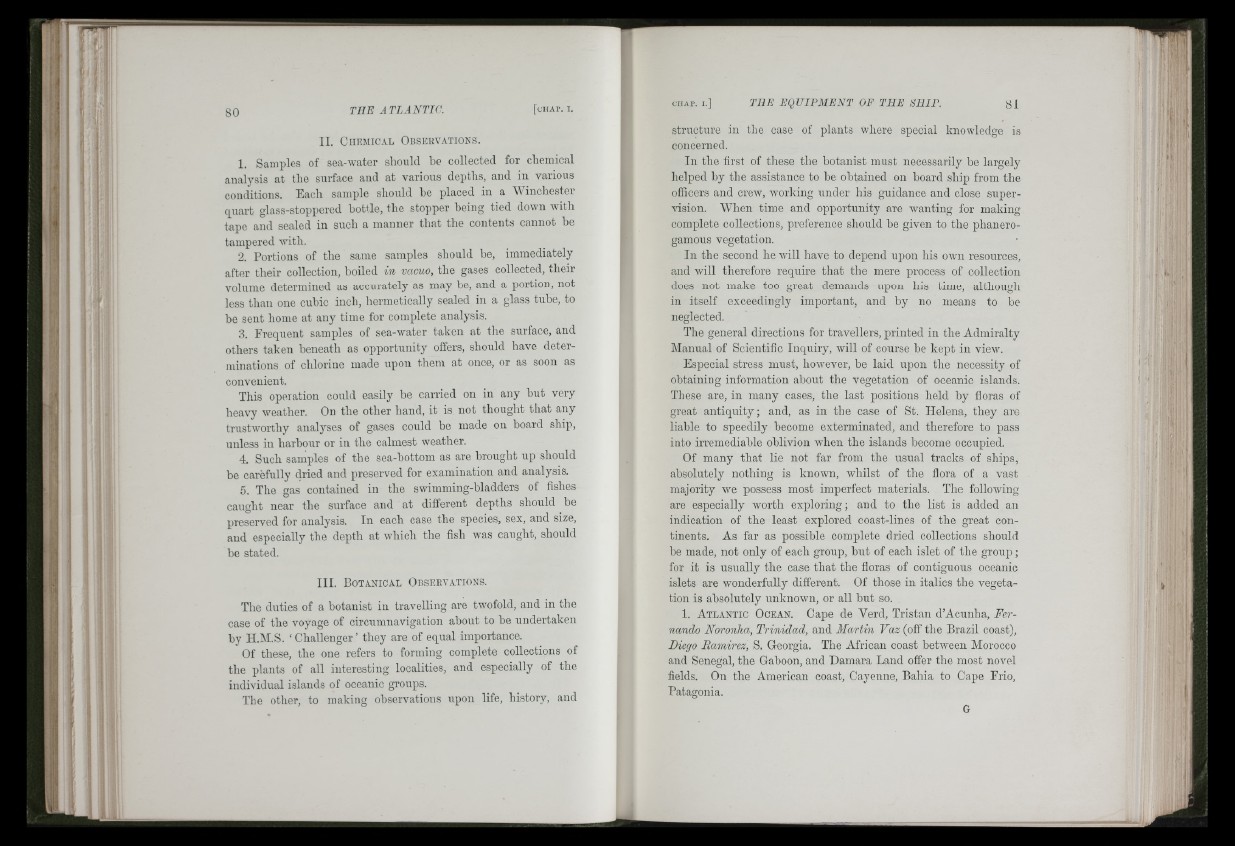
II. C h e m i c a l O b s e k v a t io n s .
1. Samples of sea-water should be collected for chemical
analysis at the surface and at various depths, and in various
conditions. Each sample sliould be placed in a Winchester
quart gdass-stoppered hottle, the stopper being tied down with
tape and sealed in such a manner that the contents cannot be
tampered with.
2. Portions of the same samples should he, immediately
after their collection, boiled in vacuo, the gases collected, their
volume determined as accurately as may he, and a portion, not
less than one cubic inch, hermetically sealed in a glass tube, to
be sent liome at any time for complete analysis.
3. Frequent samples of sea-water taken at tiie surface, and
others taken beneath as opportunity offers, should have determinations
of clilorine made upon them af once, or as soon as
convenient.
This operation could easily be carried on in any but very
heavy weather. On the other hand, it is not thought that any
trustworthy analyses of gases could be made on board ship,
unless in harbour or in the calmest weather.
4. Such samples of the sea-bottom as are brouglit up should
be carefully dried and preserved for examination and analysis.
5. The gas contained in the swimming-bladders of fishes
caught near the surface and at different depths should be
preserved for analysis. In each case the species, sex, and size,
and especially the depth at which the fish was caught, should
be stated.
III. B o t a n i c a l O b s e r v a t io n s .
The duties of a botanist in travelling are twofold, and in the
case of the voyage of circumnavigation about to be undertaken
by II.M.S. ‘Challenger’ they are of equal importance.
Of these, the one refers to forming complete collections of
the plants of ail interesting localities, and especially of the
individual islands of oceanic groups.
The other, to making observations upon life, history, and
structure in tlie case of plants where special knowledge is
concerned.
In tlie first of these the botanist must necessarily be largely
lielped by tlie assistance to be obtained on board ship from the
officers and crew, working under his guidance and close supervision.
When time and opportunity are Avanting for making
complete collections, preference sliould be given to the phanerogamous
vegetation.
In the second he will have to depend upon his o a v ii resources,
and will therefore require that the mere process of collection
does not make too great demands upon his time, althongli
in itself exceedingly important, and by no means to be
neglected.
The general directions for travellers, printed in the Admiralty
Manual of Scientific Inquiry, will of course be kept in view.
Especial stress must, however, be laid upon the necessity of
obtaining information about the vegetation of oceanic islands.
Tiiese are, in many cases, the last positions held by floras of
great antiquity; and, as in the case of St. Helena, they are
liable to speedily become exterminated, and therefore to pass
into irremediable oblivion when the islands become occupied.
Of many that lie not far from the usual tracks of ships,
absolutely nothing is known, AAdiilst of the flora of a A^ast
majority Ave possess most imperfect materials. The following
are especially worth exploring; and to the list is added an
indication of the least explored coast-lines of the great continents.
As far as possible complete dried collections should
be made, not only of each group, but of each islet of the group;
for it is usually the case that the floras of contiguous oceanic
islets are wonderfully different. Of those in italics the vegetation
is ahsolutely unknown, or all but so.
1. A t l a n t i c O c e a n . Cape de Verd, Tristan d’Acunba, Fernando
Noronlia, Trinidad, and Martin Vaz (off the Brazil coast),
Diego Ramirez, S. Georgia. The African coast betAveen Morocco
and Senegal, the Gaboon, and Damara Land offer the most novel
fields. On the American coast, Cayenne, Bahia to Cape Frio,
Patagonia.
G